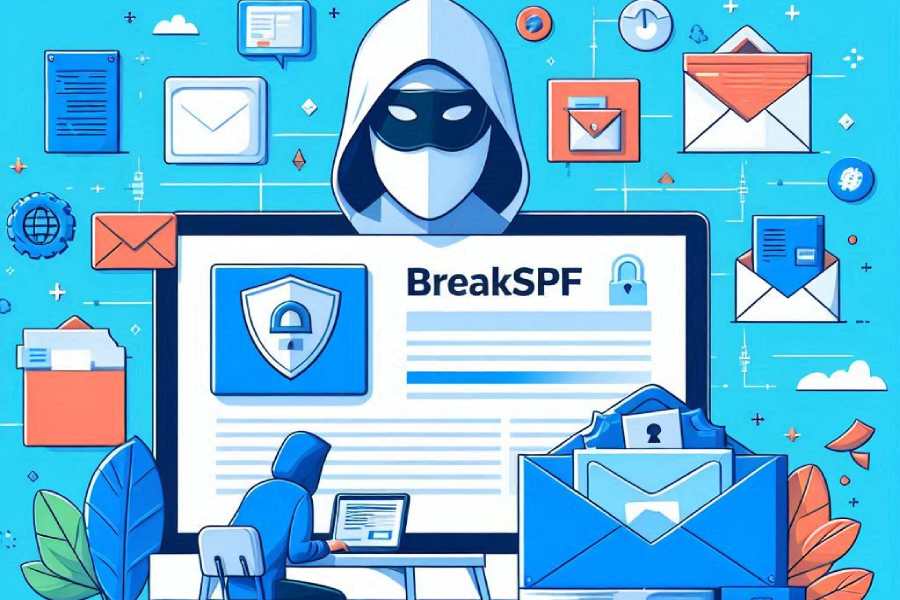BreakSPF attack- working, impact, and preventive measures
Amidst the chaos in the cybersecurity landscape, a new type of cyberattack has been surfacing: BreakSPF. This latest attack framework bypasses the SPF authentication checks, invading target recipients’ inboxes with phishing and spoofing emails. This foul technique is capable of wreaking havoc on a large scale, jeopardizing the security of millions of domains across the world.
What is a BreakSPF attack and how does it unfold?
BreakSPF is a cyberattack technique performed to attempt email spoofing. It’s usually targeted at domains with permissive SPF configurations. Permissive SPF configurations refer to settings that are too lenient that they allow unauthorized entities to send emails on your behalf without a problem. Common examples include using mechanisms like ‘include + (Pass)’ or ‘~all’ (SoftFail) excessively, which can inadvertently permit spoofed emails.
The BreakSPF attack works on the fact that several companies indulge in shared email infrastructures provided by cloud email service providers, proxies, or content delivery networks and hence have shared IPs. Broadly defined IP ranges in SPF records of shared email systems give hackers and attackers more opportunities to exploit them.
Here’s how the attack works:
- An attacker finds a domain with a permissive SPF record allowing a wide IP range (e.g., example.com).
- They use public services to access IPs within this range and send spoofed emails.
- Since these IPs match the domain’s SPF record, the spoofed emails pass SPF and DMARC checks, appearing legitimate.
This lets attackers bypass authentication and deliver fraudulent emails without needing advanced hacking techniques.
The consequences of BreakSPF attacks
Here are the possible repercussions of an attacker bypassing the SPF authentication set for your domain-
The threat to sensitive data
BreakSPF attacks can lead to successful phishing attempts, exposing sensitive and confidential data to hackers. This can severely compromise privacy and security for both individuals and organizations.
Damage to business reputation
Businesses risk losing the trust of their customers and partners when their communications are exploited in BreakSPF attacks. This erosion of trust directly impacts their reputation, making recovery challenging.
Financial and market share losses
High-profile companies may face significant financial losses and a decline in market share due to the damage to their brand image. BreakSPF attacks affect not only security but also the overall business performance.
Erosion of trust in email communication
Widespread phishing and spoofing attacks diminish trust in email as a communication medium. This forces individuals and businesses to reconsider their reliance on email, disrupting personal, professional, and marketing activities.
Broader impact across industries and regions
The consequences of BreakSPF attacks extend beyond specific industries or regions. They affect all individuals and businesses that depend on email for communication, marketing, and daily operations.
Precautions to avert BreakSPF attacks
Fortunately, preventing the BreakSPF attack isn’t too difficult; you just have to ensure your SPF record is configured correctly. Here’s what you need to be mindful of-
Keep your SPF record simple
The foremost step is to ensure there is only one SPF record corresponding to your domain. Having multiple SPF records is a cybersecurity vulnerability, as authentication checks can fail due to misconfigurations and conflicts. Combining all SPF rules into a single record ensures compatibility with email servers and compliance with standards. To keep your SPF record simple, minimize the instances of the ‘include:’ mechanisms by using online tools that aggregate multiple domains or email providers into a single ‘include:’ entry.
Also, allow only specific IP addresses or ranges that can send official emails from your domain. We recommend avoiding an overly broad range and removing legacy or unused IPs. This not only gives you a simple SPF record but also makes it easy to make changes.
Don’t exceed the lookup limit of 10
Exceeding the lookup limit of 10 prompts SPF permerror, which means your SPF record becomes invalid and inefficient in running authentication checks. This limit exists to avoid overburdening the DNS server and delays in email delivery.
If your SPF record exceeds this limit, emails sent from your domain are more likely to be marked as spam or rejected outright. To resolve this issue, use an automatic SPF flattening tool.
Regularly run your SPF record through a lookup tool
There are many online SPF lookup tools (also called SPF analyzers or SPF testers) that help you understand if there are any technical issues in your SPF record. Pick a credible tool and regularly run your SPF record through it to know and fix errors before they get exploited by threat actors.
Gaps or misconfigurations in SPF cause problems in DMARC results, disrupting the overall email security setup meant to avert phishing and spoofing attacks.
Monitor your DMARC reports
DMARC aggregate and forensic reports give insights into unsolicited and fraudulent emails sent from your domain. You also get to know if legitimate emails sent from your domain are getting subjected to false positives; if yes, there are chances that your SPF record has syntactical or configurational errors. Use a lookup tool to know the problem and fix it to prevent a BreakSPF attack.
Enforce the suitable DMARC policy
DMARC should be used with SPF and DKIM and configured with strict policies, like p=reject to avoid overly permissive settings. The p=none policy provides no protection against cyberattacks and is meant only for the initial monitoring phase.
If the ‘none’ policy is used beyond this phase, your domain will be vulnerable. Emails that fail DMARC will still be delivered, potentially containing malicious content, increasing the risk of cyberattacks.
Wrapping up
Preventing the latest BreakSPF attack will safeguard your brand reputation and keep you away from litigation while also protecting your customers, prospects, and employees. Ensuring your SPF record is always correctly configured and isn’t amiss can be daunting. But taking professional help can save you from hardships.


